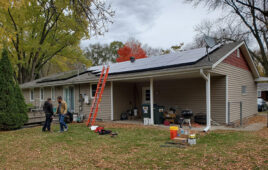The California solar and energy storage industry has been hit hard by the COVID-19 pandemic, forcing hundreds of local businesses to shed or furlough an estimated 15,000 clean energy jobs and implemented other measures to stay afloat. A new survey by the California Solar & Storage Association (CALSSA) details statewide impacts.
“Our local businesses are suffering greatly due to COVID-19,” said Bernadette Del Chiaro, executive director of CALSSA, the state’s oldest and largest clean energy business group. “Unless immediate action is taken, the impacts could harm job growth and slow California’s transition to clean, resilient and reliable energy.”
Key takeaways from the survey results include:
- 92% of solar and storage businesses report being negatively impacted.
- Businesses report laying off or furloughing 21% of their employees, indicating a loss of 15,600 solar and storage jobs statewide in the past month and a half.
- The impacts have been felt market-wide in the residential and non-residential markets.
The single greatest cause of the struggles is a slowdown in sales activity and customer engagement, which is particularly problematic given that solar and storage work typically ramps up in the spring after the rains pass. There is some indication that customer activity is ready to rebound. The second greatest challenge came from local government and utility company slowdowns or barriers to solar and storage construction activity.
Despite the impacts quantified in CALSSA’s survey, California’s solar and storage companies reported a pipeline of projects and a general sense of optimism in the future if steps are taken now to support this emerging industry.
“Local solar and energy storage projects are the most “shovel-ready” investments the state can make to put people back to work and help grow our economy around clean energy,” said Del Chiaro. “Our projects take anywhere from a few days to a few months to complete, can be done safely outdoors, and have the added value of making our communities more resilient to future disasters.”
CALSSA recommended a list of actions the government can take to help put the solar and storage industry back to work including:
- California should set a goal of building a million solar-charged batteries. Similar to when California set a goal of building a million solar roofs, significant economic activity, job growth and consumer engagement would follow from the state’s direct engagement and the resulting policies designed to achieve the goal.
- California should ensure local building departments have the resources they need to adopt online permitting portals and no-touch inspection practices. Many local governments have made great strides in online permitting to protect public health during the COVID-19 crisis. They can solidify this approach and expand on it by adopting the National Renewable Energy Lab’s SolarAPP, an advanced system that creates government efficiency in permitting.
- California should undertake a massive investment in clean energy infrastructure to boost the economy while making advancements to decarbonize our energy system and provide greater community-level resiliency. This could be funded through a combination of bond financing, tax credits, and program outlays.
- Congress should provide direct payments of tax credits for the next 18 months and extend the safe harbor provisions and commence construction deadlines at credit levels currently in place for clean energy projects. These measures will keep projects moving and ensure companies do not lose a productive year as credits decline.
- California should protect solar and storage investments from unnecessary taxes at the local level.
News item from CALSSA





“The California solar and energy storage industry has been hit hard by the COVID-19 pandemic, forcing hundreds of local businesses to shed or furlough an estimated 15,000 clean energy jobs and implemented other measures to stay afloat. A new survey by the California Solar & Storage Association (CALSSA) details statewide impacts.”
The Government keeps talking about “antibody tests for Covid-19”, the problem there seems to be a lot of tests out there that are not “reviewed” and only about 8 to 10 testing methods are considered “relatively accurate”. Concentrate on the utility and emergency response industries and test these 15,600 for antibodies. Then you know who has been exposed and apparently not effected like some have been. Put them back to work, check their temperature before work each day or if skin coloring changes and or lethargy over comes their daily routine. Send them for more testing or send them home. We need to remember, it is still Flu season as I recall the flu shot this year was only about 45% effective.
Typical lobbying body, CALSSA wants to Legislate or regulate some kind of solution , when what’s needed is putting skilled installers back to work. I imagine the technology is sitting in a warehouse somewhere waiting for a workforce to cut lose and install the products.